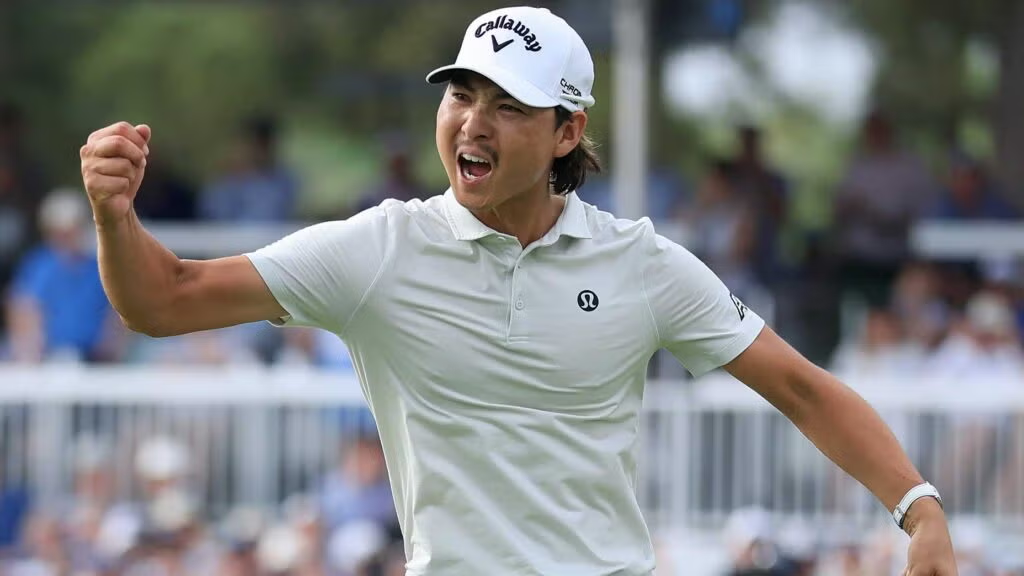Min Woo Lee won the 2025 Houston Open. Photo courtesy of Getty Images.
JAMIE HEALY | STAFF REPORTER | jdhealy1@butler.edu
Overtime, or “OT,” is an opinion column series where the Collegian takes national sports headlines or polarizing topics and gives them a Butler-centric angle.
On March 30, during the final round of the Houston Open, the final group of Alejandro Tosti and eventual winner Min Woo Lee received a great deal of attention. This focus was not on the great play of both players but rather on each player’s pace.
When playing the eighth hole, Lee hit his tee shot way right and ended up having to take an unplayable. While he and his caddie were discussing his options, the NBC broadcast chose to show Tosti’s interaction with a rules official during the 10-minute discussion.
Tosti, who is known for his fiery demeanor and quick play on the golf course, seemed irate with how long Lee was taking to come to a decision on where to play his next shot from. An NBC graphic displayed that the group took 30 minutes on the hole.
This interaction is just another example of the pace of play on the PGA Tour being criticized. While the Tour already has rules in place in order to speed up play, there needs to be an improvement in enforcement.
The Tour currently has a four-step process in assessing slow-play. The first offense in a round is a warning, followed by being “on the clock,” which alerts the players that they are lagging behind, a “freebie,” which is a non-stroke penalty and finally a one-stroke penalty.
The Tour is finally beginning to notice the pace-of-play concerns and is taking steps towards addressing the issue.
A trial program implemented on the PGA TOUR Americas brings the process down to three steps, eliminating the “freebie”. The program also lists out the allotted time per shot as 40 seconds with a ten-second increase for players who are the first to tee off on a hole for example.
Sophomore pharmacy major Andrew Dial agrees with these changes and believes that it forces players to execute at the highest level every shot.
“You can’t just sit there all day thinking about what club to use,” Dial said. “You kind of have to just know the course. You get a practice round, you should know the course by then.”
A hole-by-hole breakdown gives the average time it should take a group of three per hole: 12-14 minutes on a par-3, 14-16 on a par-4 and 17-19 on a par-5. The standard time for pace-of-play for threesomes is 4 hours and 45 minutes, while twosomes should only take 4 hours.
January’s tournaments, on the other hand, saw the final groups take almost 6 hours to complete the courses at The American Express and Farmers Insurance Open.
Immediately following the Farmers Insurance Open, the PGA Tour announced the allowance of distance-measuring devices in tournaments between the Masters and the PGA Championship. The tour is also aiming to publish pace-of-play specifics for each player near the end of 2025.
These are all needed changes, but more may need to be done in order to speed up play.
The shot clock in the TMRW Golf League (TGL) was successful in its inaugural season. The clock, which forces players to hit shots within a 40-second timeframe, allowed the 15-hole matches to fit in a two-hour window on ESPN.
First-year sports media major Isabella DiVernieri likes the implementation of the shot clock in TGL and thinks a visual representation can help players and grow the game as well.
“I would have officials have a [visual] clock that the players can see that counts down when they go to hit a stroke,” DiVernieri said. “If it’s a set amount of time, then more [viewers] can see if they want to watch and see if they like the sport.”
TGL’s shot clock and subsequent sped-up play have grabbed a younger audience, with the median age of 52 being over a decade younger than the median age of PGA Tour viewers.
If the shot clock goes off before the player takes their shot, the player is given a one-stroke penalty.
First-year exploratory communications major Colin Dwyer would like to see this implemented on tour and taken even further in order to punish slow players.
“I think at first it should be a warning and then a one-stroke penalty if it continues,” Dwyer said. “If it keeps happening, a two-stroke penalty and then upwards every single time. If it reaches four or more, they get kicked out of the event.”
While this may be a strong opinion, these punishments should be harsh in order to stop slow play from continuing. The slower a player plays, the less enjoyment fans get because they are stuck waiting for a player to take their shot.
If the PGA Tour is serious about growing the game, it needs to be willing to take significant steps to punish repeated offenders. If that means an increase in penalty strokes or disqualifications, so be it.
While the PGA Tour has taken strides to address slow play issues, the tour needs to continue to find ways to speed up play, such as a visual shot clock or an increase in penalty strokes in order to keep fans interested and tournaments flowing.



